Professors go where the wild things are
By Rebecca Esparza,’99 BBA, ’04 MBA
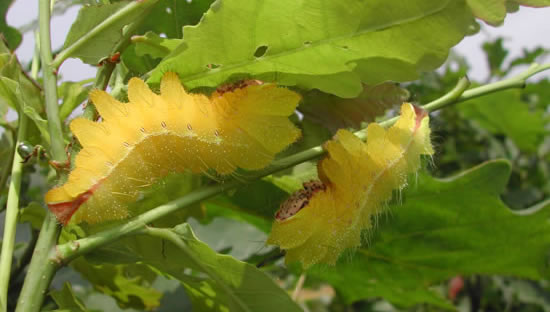
Dealing with creepy, crawly bugs and worms can be a hair-raising experience. Insects and worms are mostly considered a nuisance by many: little creatures an exterminator is paid to eliminate. But while an encounter with bugs may elicit a “flight or fight” response for some people, a few faculty members at the University of the Incarnate Word believe bugs and even parasites hold important keys to solving complex problems, bridging gaps in cultural understanding and learning more about life-threatening diseases. Read on to see what these professors are learning.
A study in silkworms
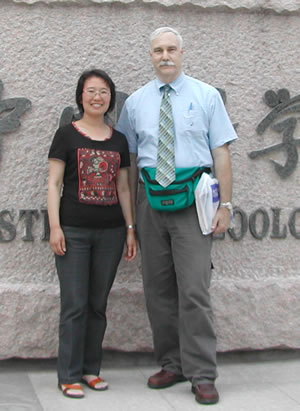
Dr. Hongxiang Han (left), assistant professor at the Chinese Academy of Sciences, stands with Dr. Richard Peigler at the Chinese Academy of Sciences in Beijing. Han was one of Peigler’s hosts while he was at the institution and is a world authority on geometrid moths.
Dr. Richard Peigler, associate professor of biology, visited China last year with some of his students to complete research on wild silkworms of the world for his upcoming book, which has a working title of “Wild Silks: Entomology, Textiles, History, Anthropology.” His passion for silkworms developed 20 years ago, while exchanging literature with scholars from India. His colleagues sent him samples of wild silk, and he was intrigued.
“My book covers all of the wild silks of the world, including a few no longer used since ancient times. I want to show textiles, weaving, cocoons, caterpillars and moths of as many species as possible,” he said. “It’s a compilation of a lot of new information, but mostly what is already published in several languages. I want to bring it all together under one cover.”
For the past 15 years, he has been tirelessly gathering photos and information for this book from libraries all over the world. During that time, he’s also published many smaller papers and two other books.
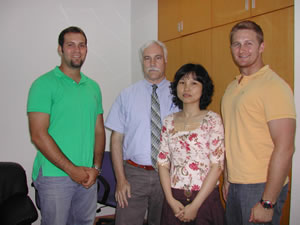
Blake McAnelly BBA ’08 (from left), Dr. Richard Peigler, Chaoyang Liu, an agent at Guangdong Silk Group Corporation, the largest exporter of silk in China, and Ryan Richardson BS ’08 worked together in China. McAnelly, a marketing major, and Richardson, an engineering management major, provided insight about silk marketing, production, and manufacturing during the trip.
Coaxing, bribing or threatening students into working with bugs has not been necessary, Peigler added. Their interest in working with insects, he said, comes naturally.
“Students who start the course saying ‘I hate bugs’ end the course saying they don't hate them anymore and find them very interesting. Having to make a collection as part of the course requirement forces students to observe and learn a lot about these creatures in the field and the lab,” he said.
With more than half of the species on Earth being insects, Peigler noted, the study of insects, known as entomology, is also a vital sub-discipline in the field of biology.
“There are thousands of entomologists out there working in agriculture and in the medical-veterinary field (fleas, ticks, mosquitoes, lice, etc.), so the public has little idea of the importance of studying insects.”
During his trip to China, Peigler focused on the tussah silkworm, which are raised outdoors on trees and are used to make fabrics for international trade.
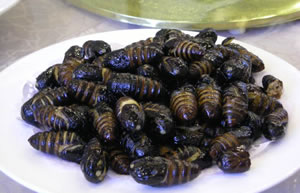
Silkworm pupae were served for dinner during the trip.
“Most are lost to birds, spiders and ants before they can make cocoons,” he said.
In China, Peigler and his students were treated to a surprise during a formal dinner hosted by some of his research colleagues. On the menu: tussah pupae.
“These are eaten locally by Chinese people. The pupae are a by-product of tussah sericulture, after the cocoons that surround the pupae are used for silk. My students and I ate just a few. They had sort of an almond taste,” he said.
Peigler stressed his book will not only educate people about silkworms, but add to the overall understanding of other cultures in an increasingly globalized world.
“A lot of information will highlight the silk-making heritage of tribal peoples in India and Africa, among others. I will also mention things like child labor, sweat shops, deforestation, fair trade practices and contributions by women to wild silk industries. Maybe some users of my book in China, India, Japan and Africa will gain a few insights on social justice.”
Ancient Parasites
Studying a parasite that co-existed with dinosaurs more than 100 million years ago might be a daunting task for some, but not for UIW Professor of Biology Dr. Sara Kerr and Assistant Professor of Biology Dr. Russell Raymond.
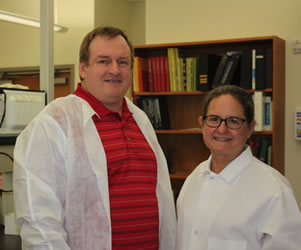
Dr. Russell Raymond and Dr. Sara Kerr
“The parasite Leishmania is a protozoan, which is a single-celled organism,” Kerr explained. “It causes the human disease leishmaniasis. In Texas, the disease is very mild, usually limited to a slow-healing sore on the skin. Deadly or severely disfiguring forms of this disease exist in other parts of the world.”
Across the globe, the disease is known by a variety of names. It's known as “Chiclero’s Ulcer” in Mexico, because it mainly affects the men who climb trees to gather chicle, which is used to make chewing gum. In Nicaragua, it is called “Lepra del Montana” for its resemblance to leprosy, usually afflicting people living in the mountains.
“The parasite requires a mammal host and a sand fly vector to complete its life cycle. Humans get the disease when they are bitten by an infected sand fly,” she said.
Her research with the parasite began in 1989 when she set out to discover how people in South Texas were contracting leishmaniasis.
“My husband, Dr. Chad McHugh, a medical entomologist at Brooks City Base, thought the host of the parasite was probably a woodrat. Since I am a wildlife biologist, he asked me to help him find a woodrat infected with Leishmania. We almost immediately collected an infected woodrat,” she recalled.
Soon, they became the first scientists to prove the life cycle of Leishmania in South Texas. Since then, they have conducted similar studies in other parts of the country, as well as in Nicaragua.
Raymond joined her on the project in 1997, while an undergraduate biology major at UIW.
“I was looking for field experience in scientific research to compliment my classroom education. Science always has been an interest of mine, and this project gave me an excellent opportunity to conduct some first-hand field and laboratory experiments. Plus, it dealt with parasites, which I find fascinating. Leishmaniasis is a disease that causes significant mortality and morbidity in many parts of the world, and I was intrigued by the fact the parasite could be found in this part of Texas as well," said Raymond, who later obtained his graduate degree in biology at UIW.
Research by Raymond and Kerr recently aired on Animal Planet in a series called "Monsters Inside Me."
Kerr's biology graduate students assist with the research, while her undergraduates become involved through classes and the McNair Scholars Program, she said.
“I hope to discover the full range of mammalian hosts and sand fly vectors for Leishmania. Others can use this information to prevent disease transmission to humans,” Kerr explained.
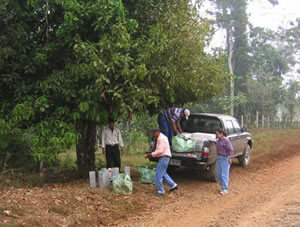
Dr. Sara Kerr supervised the collecting of rats in Nicaragua for research.
Funding for their research has come primarily from the National Institutes of Health Minority Biomedical Research Support (MBRS) program, which UIW has participated in since the program originated.
“Sr. Mary Daniel Healy originated the MBRS program at UIW, in the late 1960s or early 1970s,” she said. “We were among the first schools to participate.”
So how do her students feel about looking for a prehistoric parasite in rats and other small animals?
“Students enjoy gaining practical field and laboratory experiences,” she said. “Most students are pleased that primary research is being conducted at UIW and are interested in the results of our studies.”
But she admitted searching for parasites is not for the faint of heart.
“For some, a life spent crawling through prickly pear cactus to trap rats and flies in search of parasites, when the temperature is 100 degrees and you could get covered with ticks, fire ants or bitten by rattlesnakes, holds no appeal at all. Some of the graduate students much prefer laboratory work!”
Understandably so.
Searching for Cures
Dr. Veronica Martinez Acosta, assistant professor of biology, can envision a day when neurological disorders like Alzheimer’s and Parkinson’s can be managed with specialized medical therapies. Few people can say their work includes finding a cure for diseases that affect millions of patients and their families. Not only is Martinez Acosta doing so, she is also including her students in the pioneering research.
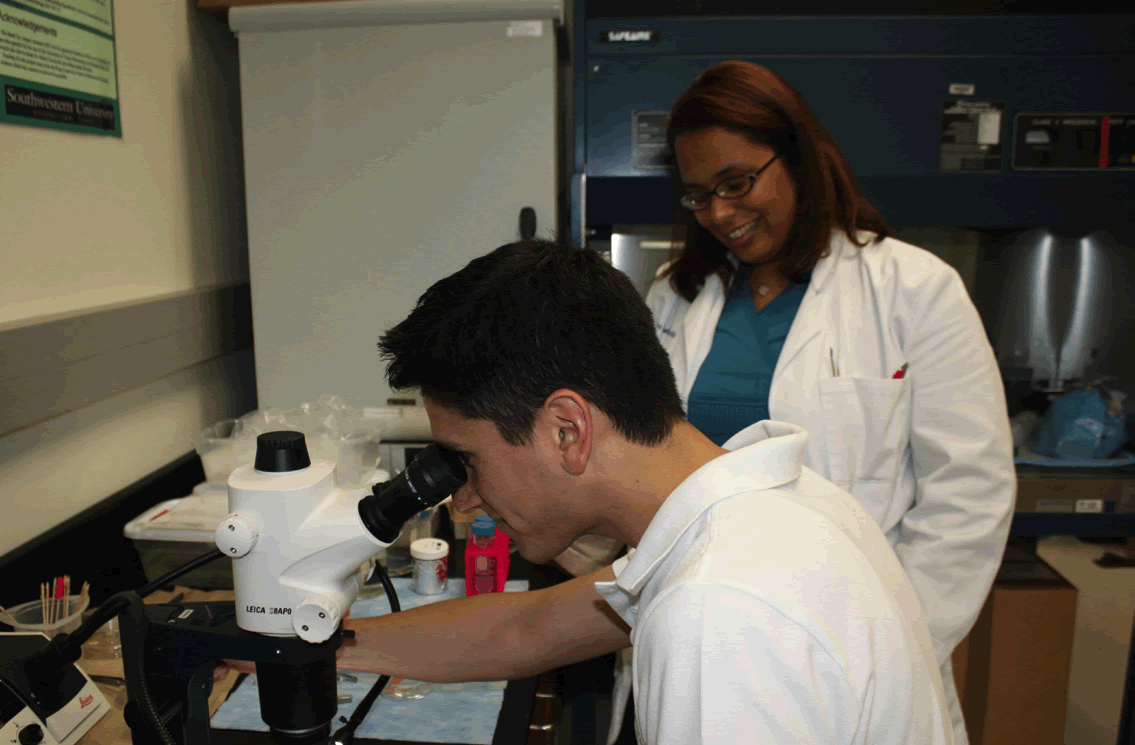
Gabriel Leal, a senior biology major, works with Dr. Veronica Martinez Acosta as part of the Faculty of Undergraduate Neuroscience for their Support of Mentors and their Students program.
For the past 10 years, including time spent researching for her doctoral thesis at Texas A&M University, she has been studying a specific type of regeneration called morphallaxis within the nervous system of the California Blackworm.
“Our research goal is to understand at the cellular and molecular level how this tiny worm fragment is able to determine its new body position and therefore regenerate appropriate structures and nervous system,” she explained. “This type of knowledge may also be helpful in the development of regenerative therapies for spinal cord injury patients.”
She chose the California Blackworm because of its ability to regenerate another entire worm from a fragment as small as just three segments long. Considering that the intact worm is less than an inch long, that’s quite an accomplishment.
“These worms can replace lost body parts with new cell growth and without new cell growth,” Martinez Acosta said. “Their central nervous system is similar to ours. As a worm fragment regenerates, it must determine which body parts need replacing. Their system somehow determines the appropriate neural connections that must be made so these little regenerating pieces of worm are able to behave appropriately for their new body position.”
Nervous system regeneration is the re-growth of a nerve cell so it is able to restore nerve function after it is lost.
“As mammals we struggle with central nervous system regeneration because, although the nerves of our central nervous system are able to regenerate, this process is cut short because the body perceives a regenerating nerve as a threat to the blood-brain barrier or there is too much scar tissue to overcome, which generally results in the death of the regenerating nerve,” she said.
Earlier this year, Martinez Acosta was one of just four professors from across the nation chosen for a competitive summer grant offered by the Faculty of Undergraduate Neuroscience (FUN), a group devoted to education and research in neuroscience at the undergraduate level, for their Support of Mentors and their Students program (SOMAS). The $9,000 grant will support her research alongside her students.
The prestigious award and program is supported by the Howard Hughes Medical Institute and the National Science Foundation.
Her work studying the California Blackworm involves an intricate understanding of the human nervous system, which can be divided into two main groups: the central nervous system and the peripheral nervous system.
The central nervous system contains the nerves of the brain and the spinal cord. The peripheral nervous system contains the nerves that lie outside the central nervous system and largely carry out the commands.
“A good example is the nervous system reflex response. Here, the nerves of the brain control the motor nerves which are directly connected to muscle and thus control muscle response. If you touch a hot plate, your brain sends a message to the motor nerves of the peripheral nervous system to retract your hand. Similarly, in the case of the California Blackworm, it contains a central nervous system which controls peripheral nerves resulting in the head-specific and tail-specific behaviors,” she said.
Growing up, Martinez Acosta always had an insatiable appetite for learning, which she tries to instill in her students as well.
“My mom often grew tired of my constant questions of ‘Why?’ and made many trips to the library so I could find the answers to all of my questions. I loved the natural world and wanted to know how everything worked. So, now as a professor, I find myself in the ideal situation, where I can satiate my desire to know everything about science and the natural world, as well as teach others about what I learn.”
